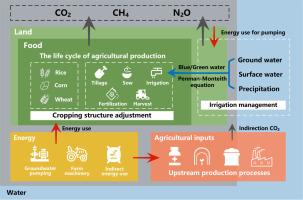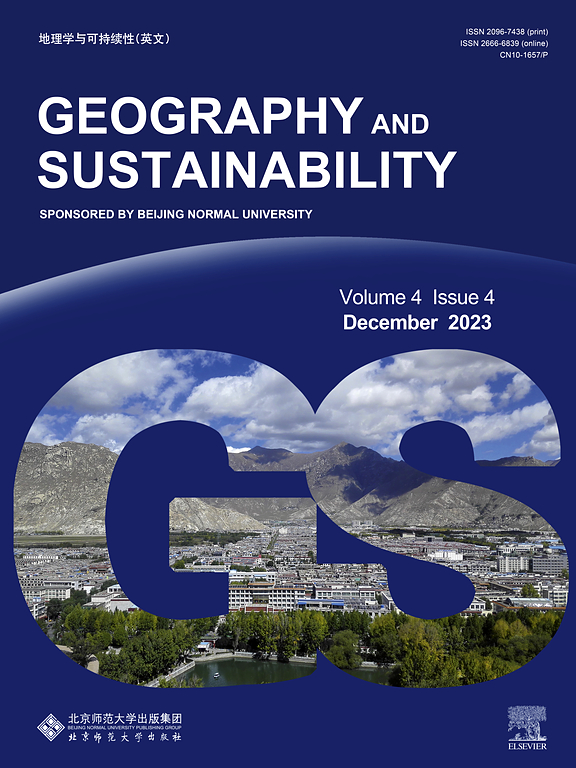土地-水-能源-温室气体联系框架为农业减缓气候变化提供信息:以华北平原为例
IF 8
1区 环境科学与生态学
Q1 GEOGRAPHY, PHYSICAL
引用次数: 0
摘要
农业生产中涉及的土地、水、能源使用和温室气体(GHG)排放具有内在联系。然而,这些元素内在相互关系的定量表征和情景模拟仍然很少。建立了华北平原陆地-水-能源-温室气体(LWEG)联系框架。该框架确定了这四个要素在农业生产生命周期中的相互反馈关系。我们应用该框架评估了新农村地区冬小麦、夏玉米和水稻的农业温室气体减排潜力。结果表明,优化种植结构可减少196 Mt CO2e的温室气体排放。控制作物生产上游过程的间接能源消耗,减少现场能源使用,降低了单位面积农业温室气体排放量和强度。由于土地、水和能源之间的协同作用,结合地下水管理、肥料和能源控制等多种措施的联结管理具有巨大的温室气体缓解潜力。nexus管理情景产生的温室气体总量为15951 Mt CO2e,比基线情景减少15.38%。本研究量化了农业生产过程中的LWEG关系,并确定了将水、节能和减排结合起来的农业管理实践,这些实践有助于实现可持续发展目标。本文章由计算机程序翻译,如有差异,请以英文原文为准。

A land–water–energy–greenhouse gas nexus framework informs climate change mitigation in agriculture: A case study in the North China Plain
The land, water, energy use, and greenhouse gas (GHG) emissions involved in agricultural production are intrinsically linked. However, quantitative characterization and scenario simulations of these elements’ inherent interrelationships remain scarce. We developed a land–water–energy–GHG (LWEG) nexus framework for the North China Plain (NCP). The framework identifies the mutual feedback in the life cycle of agricultural production among the four factors. We applied the framework to assess the agricultural GHG mitigation potential for winter wheat, summer maize, and rice in NCP municipalities. The results showed that cropping structure optimization reduced GHG emissions by 1.96 Mt CO2e. Controlling indirect energy consumption in upstream processes of crop production and reducing on-site energy use reduced the volume and intensity per unit area of agricultural GHG emissions. Because of the synergies between land, water, and energy, nexus management, which combines multiple measures of groundwater management, fertilizer, and energy control, has substantial GHG mitigation potential. The nexus management scenario produced a total GHG of 159.51 Mt CO2e, a decrease of 15.38 % from the baseline scenario. This study quantifies the LWEG nexus within agricultural production processes and identifies agricultural management practices that integrate water, energy conservation, and emissions mitigation contributing to the Sustainable Development Goals.
求助全文
通过发布文献求助,成功后即可免费获取论文全文。
去求助
来源期刊

Geography and Sustainability
Social Sciences-Geography, Planning and Development
CiteScore
16.70
自引率
3.10%
发文量
32
审稿时长
41 days
期刊介绍:
Geography and Sustainability serves as a central hub for interdisciplinary research and education aimed at promoting sustainable development from an integrated geography perspective. By bridging natural and human sciences, the journal fosters broader analysis and innovative thinking on global and regional sustainability issues.
Geography and Sustainability welcomes original, high-quality research articles, review articles, short communications, technical comments, perspective articles and editorials on the following themes:
Geographical Processes: Interactions with and between water, soil, atmosphere and the biosphere and their spatio-temporal variations;
Human-Environmental Systems: Interactions between humans and the environment, resilience of socio-ecological systems and vulnerability;
Ecosystem Services and Human Wellbeing: Ecosystem structure, processes, services and their linkages with human wellbeing;
Sustainable Development: Theory, practice and critical challenges in sustainable development.
 求助内容:
求助内容: 应助结果提醒方式:
应助结果提醒方式:


